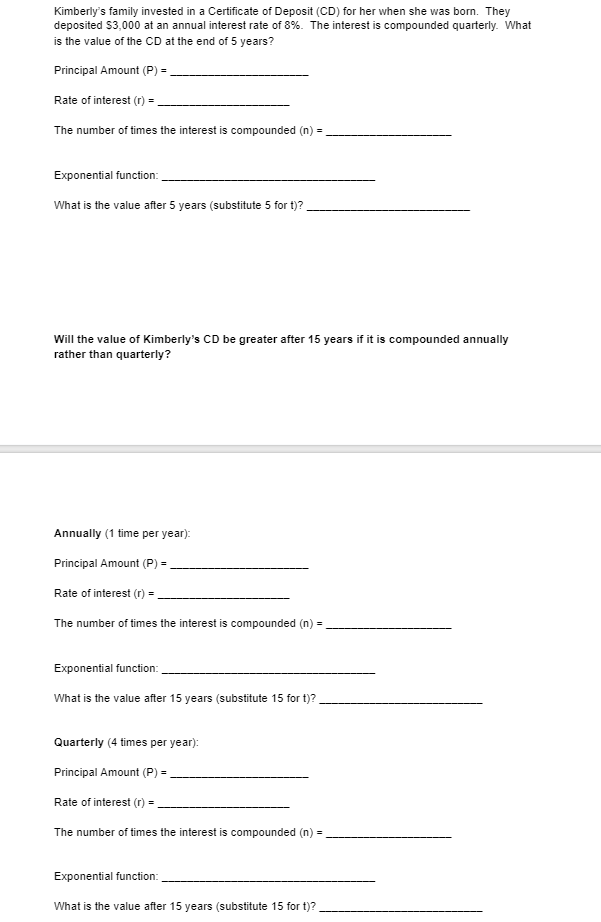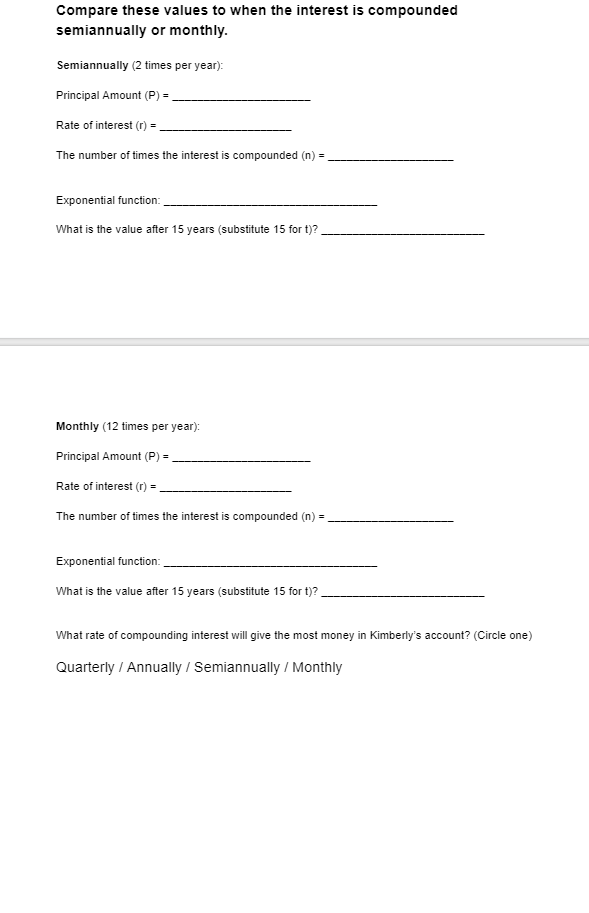Kimberly's family invested in a Certificate of Deposit (CD) for her when she was born. They deposited S3,000 at an annual interest rate of 8%. The interest is compounded quarterly. What is the value of the CD at the end of 5 years? Principal Amount (P) = Rate of interest (r) = The number of times the interest is compounded (n) = Exponential function: What is the value after 5 years (substitute 5 for t)? Will the value of Kimberly's CD be greater after 15 years if it is compounded annually rather than quarterly? Annually (1 time per year): Principal Amount (P) = Rate of interest (r) = The number of times the interest is compounded (n) = Exponential function: What is the value after 15 years (substitute 15 for t)? Quarterly (4 times per year): Principal Amount (P) = Rate of interest (r) = The number of times the interest is compounded (n) = Exponential function: What is the value after 15 years (substitute 15 for t)?
Kimberly's family invested in a Certificate of Deposit (CD) for her when she was born. They deposited S3,000 at an annual interest rate of 8%. The interest is compounded quarterly. What is the value of the CD at the end of 5 years? Principal Amount (P) = Rate of interest (r) = The number of times the interest is compounded (n) = Exponential function: What is the value after 5 years (substitute 5 for t)? Will the value of Kimberly's CD be greater after 15 years if it is compounded annually rather than quarterly? Annually (1 time per year): Principal Amount (P) = Rate of interest (r) = The number of times the interest is compounded (n) = Exponential function: What is the value after 15 years (substitute 15 for t)? Quarterly (4 times per year): Principal Amount (P) = Rate of interest (r) = The number of times the interest is compounded (n) = Exponential function: What is the value after 15 years (substitute 15 for t)?
Chapter6: Exponential And Logarithmic Functions
Section6.1: Exponential Functions
Problem 67SE: Alyssa opened a retirement account with 7.25 APRin the year 2000. Her initial deposit was 13,500....
Related questions
Concept explainers
Contingency Table
A contingency table can be defined as the visual representation of the relationship between two or more categorical variables that can be evaluated and registered. It is a categorical version of the scatterplot, which is used to investigate the linear relationship between two variables. A contingency table is indeed a type of frequency distribution table that displays two variables at the same time.
Binomial Distribution
Binomial is an algebraic expression of the sum or the difference of two terms. Before knowing about binomial distribution, we must know about the binomial theorem.
Topic Video
Question
Sorry this one is long

Transcribed Image Text:Kimberly's family invested in a Certificate of Deposit (CD) for her when she was born. They
deposited S3,000 at an annual interest rate of 8%. The interest is compounded quarterly. What
is the value of the CD at the end of 5 years?
Principal Amount (P) =
Rate of interest (r) =
The number of times the interest is compounded (n) =
Exponential function:
What is the value after 5 years (substitute 5 for t)?
Will the value of Kimberly's CD be greater after 15 years if it is compounded annually
rather than quarterly?
Annually (1 time per year):
Principal Amount (P) =
Rate of interest (r) =
The number of times the interest is compounded (n) =
Exponential function:
What is the value after 15 years (substitute 15 for t)?
Quarterly (4 times per year):
Principal Amount (P) =
Rate of interest (r) =
The number of times the interest is compounded (n) =
Exponential function:
What is the value after 15 years (substitute 15 for t)?

Transcribed Image Text:Compare these values to when the interest is compounded
semiannually or monthly.
Semiannually (2 times per year):
Principal Amount (P) =
Rate of interest (r) =.
The number of times the interest is compounded (n) =
Exponential function:
What is the value after 15 years (substitute 15 for t)?
Monthly (12 times per year):
Principal Amount (P):
Rate of interest (r) =,
The number of times the interest is compounded (n) =
Exponential function:
What is the value after 15 years (substitute 15 for t)?
What rate of compounding interest will give the most money in Kimberly's account? (Circle one)
Quarterly / Annually / Semiannually / Monthly
Expert Solution
This question has been solved!
Explore an expertly crafted, step-by-step solution for a thorough understanding of key concepts.
This is a popular solution!
Trending now
This is a popular solution!
Step by step
Solved in 2 steps with 2 images

Knowledge Booster
Learn more about
Need a deep-dive on the concept behind this application? Look no further. Learn more about this topic, algebra and related others by exploring similar questions and additional content below.Recommended textbooks for you


Glencoe Algebra 1, Student Edition, 9780079039897…
Algebra
ISBN:
9780079039897
Author:
Carter
Publisher:
McGraw Hill

Algebra & Trigonometry with Analytic Geometry
Algebra
ISBN:
9781133382119
Author:
Swokowski
Publisher:
Cengage


Glencoe Algebra 1, Student Edition, 9780079039897…
Algebra
ISBN:
9780079039897
Author:
Carter
Publisher:
McGraw Hill

Algebra & Trigonometry with Analytic Geometry
Algebra
ISBN:
9781133382119
Author:
Swokowski
Publisher:
Cengage

College Algebra
Algebra
ISBN:
9781305115545
Author:
James Stewart, Lothar Redlin, Saleem Watson
Publisher:
Cengage Learning


Intermediate Algebra
Algebra
ISBN:
9781285195728
Author:
Jerome E. Kaufmann, Karen L. Schwitters
Publisher:
Cengage Learning